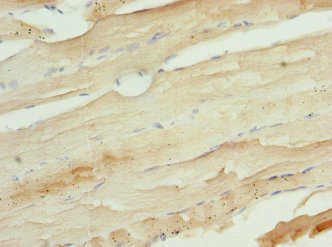UFD1 Antibody
-
货号:CSB-PA842166ESR1HU
-
规格:¥440
-
促销:
-
图片:
-
Western blot
All lanes: UFD1 antibody at 3.22µg/ml
Lane 1: HepG2 whole cell lysate
Lane 2: Raji whole cell lysate
Lane 3: MCF-7 whole cell lysate
Lane 4: Jurkat whole cell lysate
Secondary
Goat polyclonal to rabbit IgG at 1/10000 dilution
Predicted band size: 35, 39, 30 kDa
Observed band size: 35 kDa -
Immunohistochemistry of paraffin-embedded human skeletal muscle tissue using CSB-PA842166ESR1HU at dilution of 1:100
-
-
其他:
产品详情
-
产品名称:Rabbit anti-Homo sapiens (Human) UFD1 Polyclonal antibody
-
Uniprot No.:Q92890
-
基因名:
-
别名:UB fusion protein 1 antibody; Ubiquitin fusion degradation 1 like (yeast) antibody; Ubiquitin fusion degradation 1 like antibody; Ubiquitin fusion degradation protein 1 homolog antibody; UFD1 antibody; UFD1_HUMAN antibody; UFD1L antibody
-
宿主:Rabbit
-
反应种属:Human
-
免疫原:Recombinant Human Ubiquitin recognition factor in ER-associated degradation protein 1 protein (1-307AA)
-
免疫原种属:Homo sapiens (Human)
-
标记方式:Non-conjugated
-
克隆类型:Polyclonal
-
抗体亚型:IgG
-
纯化方式:Antigen Affinity Purified
-
浓度:It differs from different batches. Please contact us to confirm it.
-
保存缓冲液:PBS with 0.02% sodium azide, 50% glycerol, pH7.3.
-
产品提供形式:Liquid
-
应用范围:ELISA, WB, IHC
-
推荐稀释比:
Application Recommended Dilution WB 1:1000-1:5000 IHC 1:20-1:200 -
Protocols:
-
储存条件:Upon receipt, store at -20°C or -80°C. Avoid repeated freeze.
-
货期:Basically, we can dispatch the products out in 1-3 working days after receiving your orders. Delivery time maybe differs from different purchasing way or location, please kindly consult your local distributors for specific delivery time.
相关产品
靶点详情
-
功能:Essential component of the ubiquitin-dependent proteolytic pathway which degrades ubiquitin fusion proteins. The ternary complex containing UFD1, VCP and NPLOC4 binds ubiquitinated proteins and is necessary for the export of misfolded proteins from the ER to the cytoplasm, where they are degraded by the proteasome. The NPLOC4-UFD1-VCP complex regulates spindle disassembly at the end of mitosis and is necessary for the formation of a closed nuclear envelope. It may be involved in the development of some ectoderm-derived structures. Acts as a negative regulator of type I interferon production via the complex formed with VCP and NPLOC4, which binds to DDX58/RIG-I and recruits RNF125 to promote ubiquitination and degradation of DDX58/RIG-I.
-
基因功能参考文献:
- We demonstrate that WT p97 can unfold proteins and that this activity is dependent on the p97 adaptor NPLOC4-UFD1L, ATP hydrolysis, and substrate ubiquitination, with branched chains providing maximal stimulation. PMID: 28512218
- The study revealed a regulatory role of the p97-Npl4-Ufd1 complex in regulating a partial degradation of the NF-kappaB subunit p100. PMID: 26112410
- p97-Ufd1-Npl4 is an integral part of G2/M checkpoint signaling and thereby suppresses chromosome instability. PMID: 24429874
- Data indicate that the p97-UFD1L-NPL4 protein complex specifically associates with ubiquitinated IkappaBalpha via the interactions between p97 and the SCF(beta-TRCP) ubiquitin ligase. PMID: 24248593
- This study demonistrated that UFD1L may participate in the core cognitive deficits observed in schizophrenia. PMID: 23623450
- In coordination with the P97-UFD1-NPL4 complex (P97(UFD1/NPL4)), NUB1L promotes transfer of NEDD8 to proteasome for degradation. PMID: 24019527
- increased corpus callosum volume in children with 22q11DS is associated with UFD1L polymorphism. PMID: 22763378
- Data indicate that Npl4-Ufd1 heterodimer is required for VCP-FAF1 interaction. PMID: 23293021
- Data establish Cdc48/p97-Ufd1-Npl4 as a crucial negative regulator of Aurora B early in mitosis of human somatic cells and suggest that the activity of Aurora B on chromosomes needs to be restrained to ensure faithful chromosome segregation. PMID: 21486945
- Ubiquitin-recognition protein Ufd1 couples the endoplasmic reticulum (ER) stress response to cell cycle control PMID: 21571647
- This study suggested that AA genotype of UFD1L gene, which is involved in neurodevelopmental processes, may contribute to early-onset schizophrenia. Therefore, rs5992403 polymorphism may not be a risk factor for schizophrenia. PMID: 20471029
- Data suggest that the human cytomegalovirus dislocation reaction in US2 cells is independent of the p97 cofactor Ufd1-Npl4, and different retrotranslocation mechanisms can employ distinct p97 ATPase complexes to dislocate substrates. PMID: 20702414
- a functional analysis of its 5' regulatory region PMID: 11979512
- Ufd1l is localized around the nucleus and it does not interfere with Fas-and ceramide-mediated apoptosis. PMID: 12910480
- Ufd1-nuclear protein localization 4 is a negative regulator of retrotranslocation, delaying the retrotranslocation of endoplasmic reticulum-associated degradation substrates independently of its association with VCP PMID: 17331469
- This study identifies Ufd1 as a cofactor of gp78, reveals an unappreciated function of Ufd1 in the ubiquitination reaction during endoplasmic reticulum -associated degradation, and illustrates that Ufd1 plays a critical role in cholesterol metabolism. PMID: 17681147
- allelic associations of the UFD1L locus identified; 4-SNP haplotype analysis showed strong association with schizophrenia; possibility that a disease-resistant variant may be carried by two or more haplotypes due to frequent recombination during meiosis. PMID: 18270977
- This favors the model where the Ufd1-Npl4 dimer forms a regulatory gate at the exit from the retrotranslocone, rather than actively promoting retrotranslocation like the p97VCP ATPase. PMID: 18586029
显示更多
收起更多
-
亚细胞定位:Nucleus. Cytoplasm, cytosol.
-
蛋白家族:UFD1 family
-
组织特异性:Found in adult heart, skeletal muscle and pancreas, and in fetal liver and kidney.
-
数据库链接:
HGNC: 12520
OMIM: 601754
KEGG: hsa:7353
STRING: 9606.ENSP00000263202
UniGene: Hs.474213
Most popular with customers
-
-
YWHAB Recombinant Monoclonal Antibody
Applications: ELISA, WB, IF, FC
Species Reactivity: Human, Mouse, Rat
-
Phospho-YAP1 (S127) Recombinant Monoclonal Antibody
Applications: ELISA, WB, IHC
Species Reactivity: Human
-
-
-
-
-























